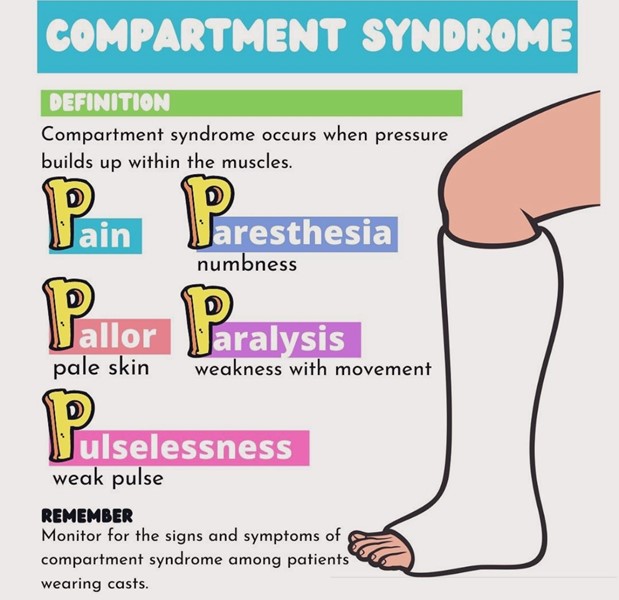The nurse is caring for a preschool child with a cast applied recently for a fractured tibia. Which assessment finding indicates possible compartment syndrome?
Pain responding well to prescribed dose of Morphine.
ltching unrelieved by Diphenhydramine (Benadryl administration.
Lower extremities temperature cool bilaterally.
Tingling in the toes of fractured extremity and decreased sensation.
The Correct Answer is D
Compartment syndrome is a condition characterized by increased pressure within a muscle compartment, leading to impaired blood flow and potential tissue damage. It can occur when swelling or bleeding within a confined space, such as a cast, causes increased pressure on the surrounding tissues.
Tingling in the toes and decreased sensation can be indicative of nerve compression or damage due to increased pressure in the compartment. It is important to recognize these neurological changes as potential signs of compartment syndrome.
Signs and symptoms of compartment syndrome may include:
- Severe pain that is out of proportion to the injury or not relieved by pain medication.
- Swelling and tightness in the affected area.
- Numbness or tingling.
- Pale or cool skin over the affected area.
- Weakness or decreased sensation in the affected limb.
- In severe cases, paralysis or loss of pulse in the affected area.

Nursing Test Bank
Naxlex Comprehensive Predictor Exams
Related Questions
Correct Answer is C
Explanation
Nitroprusside is a potent vasodilator medication used to rapidly reduce blood pressure in hypertensive emergencies. Its primary action is to dilate blood vessels, leading to a decrease in systemic vascular resistance and subsequent reduction in blood pressure.
Monitoring the client's blood pressure is crucial during the administration of nitroprusside to ensure that the medication is achieving the desired effect and that blood pressure is being appropriately controlled. The nurse will assess blood pressure frequently to adjust the infusion rate and titrate the medication to achieve the desired therapeutic effect while avoiding hypotension or other adverse effects.
Correct Answer is C
Explanation
Vesico-Ureteral Reflux (VUR) is a condition where urine flows backward from the bladder into the ureters and potentially up to the kidneys. This can increase the risk of urinary tract infections (UTIs) and potential kidney damage. By taking antibiotics for a longer duration, the aim is to prevent or reduce the occurrence of UTIs. Antibiotics help to eliminate or control bacterial growth in the urinary tract, reducing the risk of infection and associated complications. It is important to clarify that long-term antibiotic use does not cure VUR but rather helps manage the risk of UTIs.

Whether you are a student looking to ace your exams or a practicing nurse seeking to enhance your expertise , our nursing education contents will empower you with the confidence and competence to make a difference in the lives of patients and become a respected leader in the healthcare field.
Visit Naxlex, invest in your future and unlock endless possibilities with our unparalleled nursing education contents today
Report Wrong Answer on the Current Question
Do you disagree with the answer? If yes, what is your expected answer? Explain.
Kindly be descriptive with the issue you are facing.
